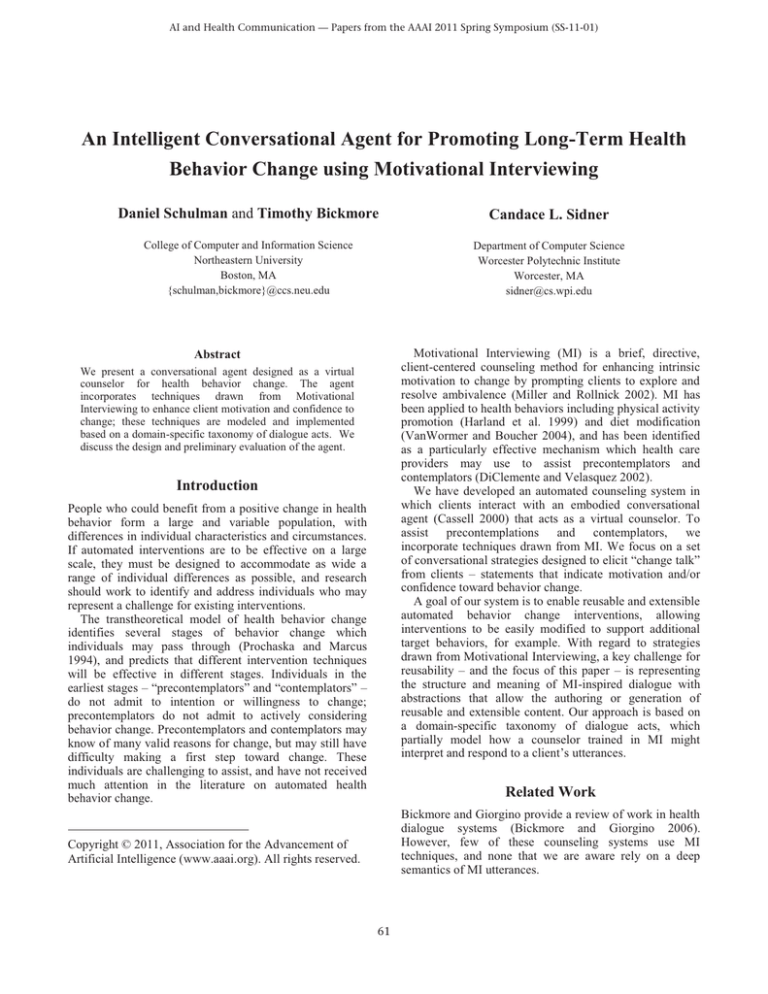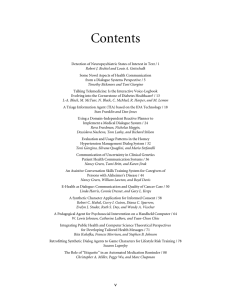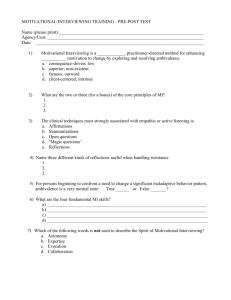
AI and Health Communication — Papers from the AAAI 2011 Spring Symposium (SS-11-01)
An Intelligent Conversational Agent for Promoting Long-Term Health
Behavior Change using Motivational Interviewing
Daniel Schulman and Timothy Bickmore
Candace L. Sidner
College of Computer and Information Science
Northeastern University
Boston, MA
{schulman,bickmore}@ccs.neu.edu
Department of Computer Science
Worcester Polytechnic Institute
Worcester, MA
sidner@cs.wpi.edu
Motivational Interviewing (MI) is a brief, directive,
client-centered counseling method for enhancing intrinsic
motivation to change by prompting clients to explore and
resolve ambivalence (Miller and Rollnick 2002). MI has
been applied to health behaviors including physical activity
promotion (Harland et al. 1999) and diet modification
(VanWormer and Boucher 2004), and has been identified
as a particularly effective mechanism which health care
providers may use to assist precontemplators and
contemplators (DiClemente and Velasquez 2002).
We have developed an automated counseling system in
which clients interact with an embodied conversational
agent (Cassell 2000) that acts as a virtual counselor. To
assist precontemplations and contemplators, we
incorporate techniques drawn from MI. We focus on a set
of conversational strategies designed to elicit “change talk”
from clients – statements that indicate motivation and/or
confidence toward behavior change.
A goal of our system is to enable reusable and extensible
automated behavior change interventions, allowing
interventions to be easily modified to support additional
target behaviors, for example. With regard to strategies
drawn from Motivational Interviewing, a key challenge for
reusability – and the focus of this paper – is representing
the structure and meaning of MI-inspired dialogue with
abstractions that allow the authoring or generation of
reusable and extensible content. Our approach is based on
a domain-specific taxonomy of dialogue acts, which
partially model how a counselor trained in MI might
interpret and respond to a client’s utterances.
Abstract
We present a conversational agent designed as a virtual
counselor for health behavior change. The agent
incorporates techniques drawn from Motivational
Interviewing to enhance client motivation and confidence to
change; these techniques are modeled and implemented
based on a domain-specific taxonomy of dialogue acts. We
discuss the design and preliminary evaluation of the agent.
Introduction
People who could benefit from a positive change in health
behavior form a large and variable population, with
differences in individual characteristics and circumstances.
If automated interventions are to be effective on a large
scale, they must be designed to accommodate as wide a
range of individual differences as possible, and research
should work to identify and address individuals who may
represent a challenge for existing interventions.
The transtheoretical model of health behavior change
identifies several stages of behavior change which
individuals may pass through (Prochaska and Marcus
1994), and predicts that different intervention techniques
will be effective in different stages. Individuals in the
earliest stages – “precontemplators” and “contemplators” –
do not admit to intention or willingness to change;
precontemplators do not admit to actively considering
behavior change. Precontemplators and contemplators may
know of many valid reasons for change, but may still have
difficulty making a first step toward change. These
individuals are challenging to assist, and have not received
much attention in the literature on automated health
behavior change.
Related Work
Bickmore and Giorgino provide a review of work in health
dialogue systems (Bickmore and Giorgino 2006).
However, few of these counseling systems use MI
techniques, and none that we are aware rely on a deep
semantics of MI utterances.
Copyright © 2011, Association for the Advancement of
Artificial Intelligence (www.aaai.org). All rights reserved.
61
of reflection: a repetition of the contents of the previous
utterance by the client, usually restated with a different
surface form.
The counselor responds to each client utterance as a
statement about the client’s motivation and confidence
toward behavior change. Utterances that do not appear to
be indications of positive change are often treated as
resistance: an indication of a lack of motivation or
confidence in behavior change, and a negative reaction to a
counselor’s attempts to elicit positive statements (Moyers
and Rollnick 2002). In this example, the client states
initially that he is not sure he wishes to have this
conversation (line 2); the counselor treats this as resistance,
rather than as a stated desire to end the interaction. Other
possible manifestations of resistance include attempts to
shift topics, or refusal to answer.
The client often makes statements that appear to express
ambivalent or inconsistent beliefs.
Statements that
acknowledge the existence of a problem and reasons for
change (lines 4, 5, 13) coexist with, and are interleaved
with statements that minimize or deny a problem (lines 7,
9, 11). The counselor’s responses assume that the client
can hold these different beliefs simultaneously, even
acknowledging the ambivalence (line 10).
1. I: Good morning. Please have a seat here. I believe you
wanted to talk about some concerns with your drinking…
perhaps you could start by telling me what your concerns
are.
2. C: Well, to tell you the truth, I’m not really sure there’s
anything to be concerned about. My wife seems to think
that I drink too much. My doctor did some blood tests… I
told her I would come here, but I’m not really sure if I
should be here.
3. I: So at least two other people, your wife and your
doctor, have been worried that maybe alcohol is harming
you. But I wonder: What have you noticed yourself? Is
there anything that you have observed about your drinking
over the years that might be reason for concern? Tell me
something about your drinking.
4. C: I guess maybe I drink more than I used to…
…
5. C: I don’t like not remembering things.
6. I: That’s doesn’t seem normal to you.
7. C: No. But I don’t think I’m an alcoholic. I’ve known
some alcoholics, and I’m not like that.
8. I: Your situation doesn’t seem so bad to you.
9. C: No it doesn’t. I’ve quit drinking for weeks at a time
with no problem. And I can have a couple of drinks and
leave it alone. I have a good job and family. How could I
be an alcoholic?
10. I: That must be confusing to you, as you think about
it. On the one hand, you can see some warning signs that
you are drinking too much, and it worries you. On the
other hand, you don’t really fit your picture of an
alcoholic.
11. C: Right. I mean I’ve got some problems, but I’m not
a drunk.
12. I: And that’s why thus far it hasn’t seemed like you
needed to do anything. But now you’re here. Why now?
13. C: It just seemed like I ought to talk to somebody. I
don’t want to ignore this. I saw what happened to my dad,
and I don’t want that to happen to me and my family.
14. I: Your family is really important to you.
A Semantics for MI Dialogue Moves
We represent Motivational Interviewing dialogue with a
domain-specific taxonomy of dialogue acts that focuses on
the information a trained counselor might use in order to
respond to client utterances. As discussed above, the
counselor focuses on eliciting and responding to client
statements about motivation and/or confidence. All
dialogue acts in our taxonomy share a common set of
features, which together describe such statements:
Valence. Statements may be either change talk, indicating
motivation and/or confidence toward change, or resistance,
indicating a lack of motivation and/or confidence.
Category. Status-quo implication and change implication
are statements that reference positive or negative aspects of
the client’s current situation or potential new situation,
respectively. Change outlook includes statements
indicating (lack of) confidence in behavior change, and
change intention indicates intention, plans, or preparation
for change.
Content. The particular topic, concern, or value expressed
in a client’s statement.
Currently, the only type of dialogue act by a client that
we model is a statement consisting of the three features
given above. In a particular client statement, some features
may be missing or unspecified. For example, a client may
respond to a question about behavior change by attempting
to shift topics; this dialogue act would be represented as
resistance with no specified category or content.
The set of dialogue acts by the counselor that we
represent includes acts intended to elicit client statements,
and acts which respond to client statements. Thus, these
acts also focus on client statements, and share the same
Figure 1. Fragments of a MI dialogue ( from Miller and Rollnick
2002; pp.141-145). I=Interviewer, C=Client
Features of MI Dialogue
The Motivational Interviewing approach to counseling
encourages a counselor to use a style of dialogue in which
the counselor rarely offers arguments, or explicit
information or advice to the client. Instead, the counselor’s
goal is to elicit statements of the client’s existing beliefs,
with the aim of helping the client to notice discrepancies
between his or her stated beliefs and values, and his or her
current behavior.
Figure 1 shows a series of excerpts from dialogue
between a client and a counselor trained in Motivational
Interviewing (adapted from (Miller and Rollnick 2002)).
The counselor’s utterances in this example are often a kind
62
A: What might be different if you
exercised regularly?
U: My health might be better.
A: Tell me more. What do you
think will be better about your
health if you exercise more?
U: Well, I probably won’t lose
weight.
A: You’re not convinced that
exercise would help you lose
weight.
Evocative Question
Change Implication
Change Talk
Change Implication
Health
Elaboration Request
Change Talk
Change Implication
Health
Resistance
Change Implication
Weight
Reflection
Resistance
Change Implication
Weight
task Reflection
input parameters: behavior, talk_valence,
talk_category, talk_content
output parameters: valence, category, content
adjacency pair:
precondition: applicable when
behavior=’exercise’ and
talk_valence=’change_talk’ and
talk_category=’status_quo_implication’ and
talk_content=’stress’
agent utterance:
You sometimes feel like you have too much stress.
user utterance:
If I did exercise, it might be better.
valence Å ‘change_talk’
category Å ‘change_implication’
content Å ‘stress’
…
U: Yeah.
A: Okay, let me just summarize
what we’ve been talking about.
A: You don’t know if exercise
would help you lose weight.
A: On the other hand, if you did
start exercising, it might improve
your health.
Summarize
Resistance
Change Implication
Weight
Summarize
Change Talk
Change Implication
Health
Figure 3. Example recipe for MI dialogue.
hierarchical task decomposition, and is based on the
ANSI/CEA-2018 standard (Rich 2009), with dialoguespecific extensions. A counseling session is represented by
a top-level task which is decomposed, using a library of
recipes, into subtasks, each encompassing a distinct portion
of the session (e.g., greeting, counseling, farewell).
DTask’s atomic tasks – each comprising a single turn of
dialogue – are based on the notion of “adjacency pairs”
(Sacks, Schegloff and Jefferson 1974), a pair of logically
related utterances. A turn of dialogue is represented by an
adjacency pair template, including an agent utterance and a
list of possible user utterances. There may be an arbitrary
number of adjacency pair templates for a particular task,
which may be selected by applicability conditions. The
surface form of agent and user utterances are natural
language utterances, but may include variables to be filled
in at runtime (template-based text generation).
Our model of MI dialogue was implemented in DTask
by defining a task for each type of agent dialogue act, such
as Reflection. For each such task, we then define a large
number of adjacency pairs, each specific to some
combination of features of the client statement that the task
is intended to respond to or elicit. In addition, a small set
of higher-level tasks determines which MI technique the
agent should use at a given point in the conversation.
We first implemented with this system an intervention
designed to promote physical activity, containing over 400
manually-authored adjacency pair templates related to MI.
The system was then extended to promote fruit and
vegetable consumption, requiring an additional 600
adjacency pairs related to MI. However, the
representations developed here allowed us to reuse nearly
all of the higher-level recipes in the system, and this
extension was completed in 10% of the time required for
the original system.
Figure 2. Samples of implemented MI dialogue and semantics.
A=Agent, U=User.
features. This is not intended to be an exhaustive list of
techniques used in Motivational Interviewing, and merely
includes techniques currently used in our system.
Evocative Question. An open-ended question, designed to
elicit client statements, and usually targeted at a specific
category. E.g., “Suppose you started exercising regularly
tomorrow. What might be different in your life?”
Elaboration Request. A prompt for additional statements,
either generically (e.g., “I see. Tell me more.”), or specific
to a category and target behavior (e.g., “Tell me more.
What kind of trouble do you think you would have with an
exercise program?”).
Reflection. A restating of the client’s previous statement,
often reworded by the counselor.
Acknowledge Importance. A statement that the value or
concern mentioned in the client’s statement is of
importance to the client.
Summarize. A restatement of client statements, often
combining and juxtaposing several statements.
Implementation
We have implemented this model of Motivational
Interviewing dialogue using the LiteBody server/client
framework for web-deployed virtual agents and the DTask
dialogue manager (Bickmore, Schulman and Shaw 2009).
DTask is a dialogue manager designed for system-directed
dialogue with restricted input. It models dialogue as a
63
Group
Exercise
Diet
Assessment
Expert/Empathy
Expert/MI Spirit
User/Satisfaction
Expert/Empathy
Expert/MI Spirit
User/Satisfaction
Dialog 2
5.33 (1.15)
5.00 (1.00)
5.57 (1.07)
6.00 (0.00)
5.00 (1.00)
5.15 (1.19)
Dialog 3
6.00 (1.00)
6.00 (1.00)
4.92 (1.43)
5.50 (0.71)
6.00 (1.41)
5.04 (1.53)
References
Amrhein, P., Miller, W., Yahne, C., Palmer, M., and
Fulcher, L. 2003. Client commitment language during
motivational interviewing predicts drug use outcomes.
Journal of Consulting and Clinical Psychology 71(5): 862878.
Bickmore, T., and Giorgino, T. 2006. Health Dialog
Systems for Patients and Consumers. J Biomedical
Informatics 39(5): 556-571
Table 1. Expert and user evaluations of an agent using MI
dialogue (mean (SD); all ratings on 7-point scales).
Bickmore, T., Schulman, D., and Shaw, G. 2009. DTask
and LiteBody: Open Source, Standards-Based Tools for
Building Web-Deployed Embodied Conversational
Agents. In Ruttkay, Z., Kipp, M., Nijholt, A., and
Vilhjálmsson, H., eds. Intelligent Virtual Agents, 425-431.
Springer Berlin / Heidelberg.
Evaluation
As part of a formative evaluation of the automated
counseling system, two separate groups of participants
interacted with a conversational agent interface, making
their contributions via touch-screen from a multiple-choice
menu. The first group (N=8, ages 21-41, 75% female)
received counseling in the domain of exercise promotion,
while the second (N=9, ages 22-68, 78% male) were
counseled in the domain of fruit and vegetable promotion.
Each participant had three conversations with the agent,
and was instructed to act as if a day had passed between
each conversation. The first conversation was an
orientation, with MI dialogue in the second two.
An expert trained in MI counseling, and not involved in
the design of the system, provided evaluations of a subset
of participant conversations, assessing empathy and
fidelity to MI using a standard instrument (Moyers et al.
2005). Participants rated overall satisfaction with the agent
following each conversation, using a set of 3 rating-scale
items (Cronbach’s alpha 0.88).
Table 1 gives descriptive statistics of the results. The
expert ratings, in particular, were surprisingly high.
Cassell, J. 2000. Embodied conversational agents. MIT
Press.
Chamberlain, P., Patterson, G., Reid, J., Kavanagh, K., and
Forgatch, M. 1984. Observation of client resistance.
Behavior Therapy 15(2): 144-155.
DiClemente, C., and Velasquez, M. 2002. Motivational
Interviewing and the Stages of Change. In Miller, W., and
Rollnick, S., eds. Motivational Interviewing: Preparing
People for Change, 201-216. Guilford Press.
Harland, J., White, M., Drinkwater, C., Chinn, D., Farr, L.,
and Howel, D. 1999. The Newcastle exercise project: a
randomised controlled trial of methods to promote physical
activity in primary care. BMJ 319(7213): 828-832.
Miller, W., and Rollnick, S. 2002. Motivational
Interviewing, Second Edition: Preparing People for
Change. The Guilford Press.
Moyers, T., Martin, T., Manuel, J., Hendrickson, S., and
Miller, W. 2005. Assessing competence in the use of
motivational interviewing. Journal of Substance Abuse
Treatment 28(1): 19-26.
Future Areas of Research
The implementation of MI dialogue developed here is
currently being evaluated (as part of a larger counseling
system) in a 4-arm, 60-day trial, comparing interventions
targeting physical activity and fruit and vegetable
promotion with a non-intervention control and with a joint
intervention that targets both behaviors.
Our taxonomy of dialogue acts is sufficient to represent
only a fragment of the meaning a trained counselor might
take from a client utterance, and finer detail could be
added. For example, clients may use different forms of
resistance, such as arguing, interrupting, and negating
(Chamberlain et al. 1984). Similarly, statements classified
as change talk may differ in strength; these differences can
be predictive of outcomes (Amrhein et al. 2003).
Finally, the manual authoring of a large number of
adjacency pairs, covering a sufficiently broad range of
topics in MI dialogue, represents a substantial
implementation effort, and future work could examine the
use of natural language generation in this area.
Moyers, T. B., and Rollnick, S. 2002. A motivational
interviewing perspective on resistance in psychotherapy. J.
Clin. Psychol. 58(2): 185-193.
Prochaska, J., and Marcus, B. 1994. The transtheoretical
model: applications to exercise. In Dishman, R., eds.
Advances in Exercise Adherence, 161-180. Human
Kinetics.
Rich, C. 2009. Building Task-Based User Interfaces with
ANSI/CEA-2018. Computer 42(8): 20-27.
Sacks, H., Schegloff, E., and Jefferson, G. 1974. A
Simplest Systematics for the Organization of Turn-Taking
for Conversation. Language 50(4): 696-735.
VanWormer, J., and Boucher, J. 2004. Motivational
interviewing and diet modification: a review of the
evidence. The Diabetes Educator 30(3): 404-419.
64





